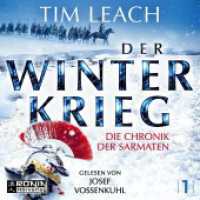Full Description
Teaching science is an awesome responsibility. The children you teach are depending on you to model good science and to teach them the skills needed to learn about our increasingly scientific and technological world. Learning and Assessing Science Process Skills is all you need to develop the knowledge and skills necessary to bring the science process skills to your students.
Features:
Big Science Ideas - in each chapter major science concepts, themes, and topics used for the process skills activities are identified. Big Science Ideas can be used to adapt the process skills activity for classroom use and to see how the activity connects to state and national science standards.
Alignment to State and National Standards - related science standards from states across the country are identified, along with National Science Education Standards and National Council of Teachers of Mathematics standards met in each chapter.
Technology Spotlight - these sections in each chapter reflect current technologies.
Web sites and Search Terms - appear in every chapter. These special boxes provide suggested words and phrases that can be used to search the Internet for additional information.
High-Stakes Testing - actual questions students were given to measure their knowledge of the related science process skill. This puts you a step ahead in planning classroom evaluation.
The Nature of Science - additional activities and information for using the process skill to teach the nature of science.
Of course the Self-Assessment Questions and Answers, Classroom Scenarios, Ideas for Your Classroom and Models for Assessing Student Learning are still included in the fifth edition, along with the engaging and meaningful activities from which you and your students will learn so much!
Learning and Assessing Science Process Skills is truly the only tool needed to competently and confidently provide exemplary science instruction.
Contents
Introduction
PART 1: BASIC PROCESS SKILLS
Chapter 1: Building a Foundation for Teaching Process Skills
National and State Standards Connections
Materials Needed
Purpose
Objectives
Opportunity, High Standards, and Accountability
The Basic and Integrated Science Process Skills
The Basic Process Skills
The Integrated Process Skills
The Nature of Science
Science Relies on Empirical Evidence
Activity 1.1 Observing and Experimenting with Water Drops
Differentiating Between Observations and Inferences
Activity 1.2 Making Multiple Inferences to Explain Observations
Activity 1.3 Observing and Explaining a Unique Drawing
Activity 1.4 Differentiating Between Observations and Inferences
Doing Science Is a Creative Enterprise
Activity 1.5 Doing Science Is a Creative Enterprise
Scientific Knowledge Is Never Proven. It Is Tentative, but Durable
Activity 1.6 Observing a Falling Object
Laws and Theories Are Different Types of Scientific Knowledge
Activity 1.7 Laws and Theories Are Different Types of Scientific Knowledge
Science Is Influenced and Affected by What Is Going on in the World. Scientists Cannot Be Completely Objective
Activity 1.8 Outside Influences
Science Cannot Answer All Questions
Activity 1.9 Questions That Can Be Answered Through Science
Habits of Mind
Activity 1.10 Scientific Habits of Mind
Using Cooperative Groups to Enhance Process Skills Teaching
Becoming a Reflective Teacher
Reflections on Science Teaching
Your Vision for Science Teaching
Searching the Web
References
Self-Check
Chapter 2: Observing
National and State Standards Connections
Materials Needed
Classroom Scenario
Purpose
Objectives
Activity 2.1 Using All Your Senses
Qualitative and Quantitative Observations
Activity 2.2 Making Qualitative and Quantitative Observations
Observing Changes
Activity 2.3 Observing the Production of a Gas
Self-Assessment
Ideas for Your Classroom
Start Kids Thinking
High Stakes Testing
Websites and Search Terms
Technology Spotlight
A Model for Assessing Student Learning
Becoming a Reflective Teacher
Self-Check
Chapter 3: Communicating
National and State Standards Connections
Materials Needed
Classroom Scenario
Purpose
Objectives
Activity 3.1 Using Good Descriptors
Communicating Descriptions
Activity 3.2 Describing Objects to Others
Practicing Using Communication Tools
Activity 3.3 Using a Rubric to Evaluate a Communication
Activity 3.4 Giving and Following Directions
Communicating with Maps
Activity 3.5 Working with Maps
Activity 3.6 Practice Making and Following Maps
Self-Assessment
Ideas for Your Classroom
Start Kids Thinking
High Stakes Testing
Websites and Search Terms
Technology Spotlight
A Model for Assessing Student Learning
Becoming a Reflective Teacher
Self-Check
Chapter 4: Classifying
National and State Standards Connections
Materials Needed
Purpose
Objectives
Binary Classification
Activity 4.1 Constructing a Binary Classification System Based on Observable Properties
Mapping an Organization Scheme
Activity 4.2 Using Several Properties at Once
Activity 4.3 Constructing a Multi-Stage Classification System
Activity 4.4 Multi-Stage Classification: Additional Practice
Serial Ordering
Activity 4.5 Serial Ordering: Properties of Cereals
Self-Assessment
Ideas for Your Classroom
Start Kids Thinking
High Stakes Testing
Websites and Search Terms
Technology Spotlight
A Model for Assessing Student Learning
Becoming a Reflective Teacher
Self-Check
Chapter 5: Measuring Metrically
National and State Standards Connections
Materials Needed
Purpose
Objectives
Activity 5.1 A Metric Treasure Hunt
Measuring Metrically
Activity 5.2 Matching Measurements
Metric Prefixes
Activity 5.3 Understanding Metric Prefixes
Activity 5.4 Measuring Lengths Metrically
Measuring Mass Metrically
Activity 5.5 Finding the Mass
Activity 5.6 Measuring Volumes Metrically
Optional Activity 5.7 Making an Overflow Container
Measuring Temperature Metrically
Activity 5.8 Changing Temperatures
Measuring Forces Metrically
Activity 5.9 Measuring Forces
Self-Assessment
Ideas for Your Classroom
Start Kids Thinking
High Stakes Testing
Websites and Search Terms
Technology Spotlight
A Model for Assessing Student Learning
Becoming a Reflective Teacher
Self-Check
Chapter 6: Inferring
National and State Standards Connections
Materials Needed
Purpose
Objectives
Constructing Inferences from Observations
Activity 6.1 Constructing Inferences from Observations
Activity 6.2 More Practice Making Inferences from Observations
Activity 6.3 Formulating Inferences from Observations about Events
Activity 6.4 Making Inferences from a Slice of Life
Learning Is an Inference
Thinking Is All about Asking Questions
Confidence in Inferences
Accepting, Rejecting, and Modifying Inferences
Activity 6.5 Compass Direction and Magnetism
Drawing Conclusions
Self-Assessment
Ideas for Your Classroom
Start Kids Thinking
High Stakes Testing
Websites and Search Terms
Technology Spotlight
A Model for Assessing Student Learning
Becoming a Reflective Teacher
Self-Check
Chapter 7: Predicting
National and State Standards Connections
Materials Needed
Purpose
Objectives
Predicting Is a Powerful Teaching and Learning Tool
Activity 7.1 Distinguishing among Observation, Inference, and Prediction
Testing Our Mental Models
Constructing Predictions Based on Observed Patterns
Activity 7.2 Finding a Pattern in Sunrises
Practice in Making Predictions
Activity 7.3 Pendulum Motion
Activity 7.4 Making Dependable Predictions
Activity 7.5 Prediction and Chance
Optional Activity 7.6 Estimating Large Quantities
Self-Assessment
Ideas for Your Classroom
Start Kids Thinking
High Stakes Testing
Websites and Search Terms
Technology Spotlight
A Model for Assessing Student Learning
Becoming a Reflective Teacher
Self-Check
Decision Making 1: Applying Your Skills
Textbook Example A
Typical Activity
Modified Activity
Textbook Example B
Typical Activity
Modified Activity
Additional Practice
PART 2: INTEGRATED SCIENCE PROCESS SKILLS
Chapter 8: Identifying Variables
National and State Standards Connections
Materials Needed
Purpose
Objectives
Changing Variables to Affect Results
Activity 8.1 Getting Involved in Experimenting
Identifying Variables in a Variety of Contexts
Activity 8.2 Learning to Identify Variables
Activity 8.3 Distinguishing Between Independent and Dependent Variables
Self-Assessment
High Stakes Testing
Websites and Search Terms
A Model for Assessing Student Learning
Self-Check
Chapter 9:Constructing a Table of Data
National and State Standards Connections
Purpose
Objectives
Working with Data
Activity 9.1 Labeling Columns and Entering Data
Activity 9.2 Modifying a Table of Data to Record Repeated Trials
Activity 9.3 Transferring Data from a Table to a Graph
Self-Assessment
High Stakes Testing
Websites and Search Terms
A Model for Assessing Student Learning
Self-Check
Chapter 10:Constructing a Graph
National and State Standards Connections
Purpose
Objective
Three Skills to Construct a Graph from Data
Activity 10.1 Skill 1: Labeling the X and Y Axes
Activity 10.2 Skill 2: Determining Interval Scales for Each Axis
Activity 10.3 Skill 3: Plotting Data Pairs as Points on a Graph
Graph Titles
Critiquing Graphs
Activity 10.4 Is the Graph Correct?
Self-Assessment
High Stakes Testing
Websites and Search Terms
A Model for Assessing Student Learning
Self-Check
Chapter 11: Describing Relationships between Variables
National and State Standards Connections
Purpose
Objectives
Interpreting a Graph
Activity 11.1 Drawing a Best-Fit Line
Writing a Statement of Relationship
Activity 11.2 Writing a Statement of Relationship for Straight Lines
Activity 11.3 Writing a Statement of Relationship for Lines That Curve
Analyzing Graphs and Statements That Summarize Trends in Data
Activity 11.4 Analyzing Graphs and Statements
Activity 11.5 Applying All Your Graphing Skills
Self-Assessment
High Stakes Testing
Websites and Search Terms
A Model for Assessing Student Learning
Self-Check
Chapter 12: Acquiring and Processing Your Own Data
National and State Standards Connections
Materials Needed
Purpose
Objectives
Initiating Investigations
Measurement Skills
Activity 12.1 Initiating an Investigation with a "Why" Question
Activity 12.2 Initiating an Investigation with an Activity and a Question
Activity 12.3 Another Question and an Activity to Answer It
Self-Assessment
High Stakes Testing
Websites and Search Terms
A Model for Assessing Student Learning
Self-Check
Chapter 13: Analyzing Investigations
National and State Standards Connections
Purpose
Objectives
Controlled Experiments
Activity 13.1 Holding Factors Constant
Hypotheses
Activity 13.2 Constructing Well-Stated Hypotheses
Self-Assessment
High Stakes Testing
Websites and Search Terms
A Model for Assessing Student Learning
Self-Check
Chapter 14:Constructing Hypotheses
National and State Standards Connections
Purpose
Objectives
Variables
Activity 14.1 Identifying Variables to Test
Constructing Testable Hypotheses
Activity 14.2 Stating a Hypothesis
Activity 14.3 Putting It All Together
Self-Assessment
High Stakes Testing
Websites and Search Terms
A Model for Assessing Student Learning
Self-Check
Chapter 15: Defining Variables Operationally
National and State Standards Connections
Purpose
Objectives
Operational Definitions
Activity 15.1 Deciding How Variables Can Be Measured
Activity 15.2 More Practice Writing Operational Definitions
Self-Assessment
High Stakes Testing
Websites and Search Terms
A Model for Assessing Student Learning
Self-Check
Chapter 16: Designing Experiments
National and State Standards Connections
Purpose
Objectives
Experiments
Activity 16.1 Identifying Essential Experimental Design Components
Activity 16.2 Writing Procedures
Activity 16.3 Analyzing Investigations: Grass Clippings
Activity 16.4 Analyzing Investigations: Soap Bubbles
Designing Experiments
Activity 16.5 Designing Your Own Experiment about Image Sizes







